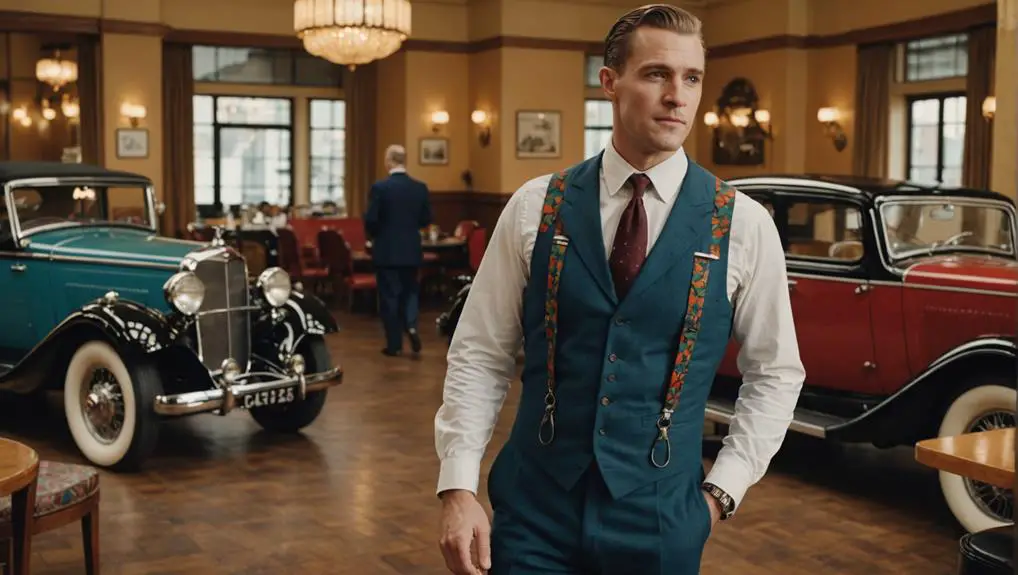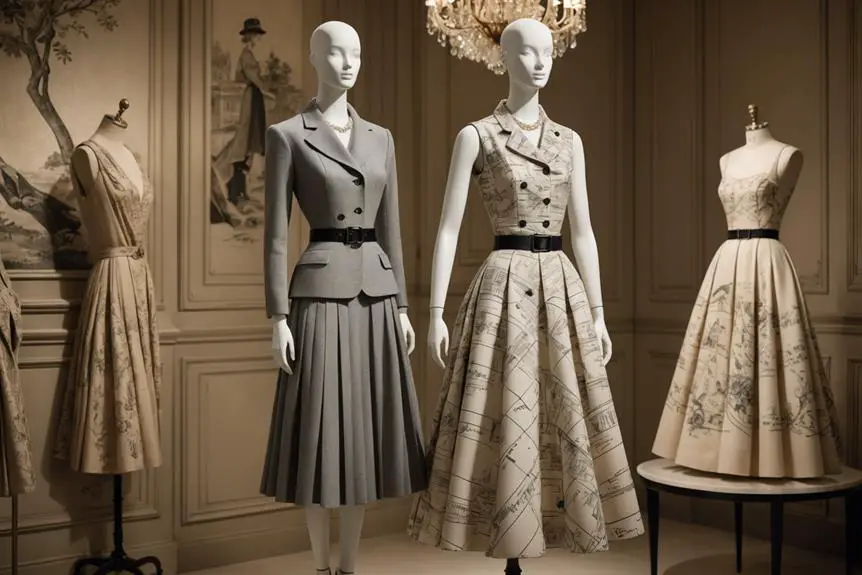In the 1930s, men's suspenders transformed into prominent fashion statements, not just functional pieces. As high-waisted trousers became the norm, suspenders offered both style and support, complementing the sleek silhouettes of the time. You'd find various designs, from elegant silk jacquards to casual cotton options, featuring bold patterns and vibrant colors. Influential figures like Cary Grant and Fred Astaire popularized these accessories, enhancing their status in men's fashion. The materials and artistry allowed for individual expression, bridging practicality with sophistication. Explore how this era shaped modern perceptions of suspenders and their enduring legacy in today's fashion landscape.
Overview of 1930s Suspenders
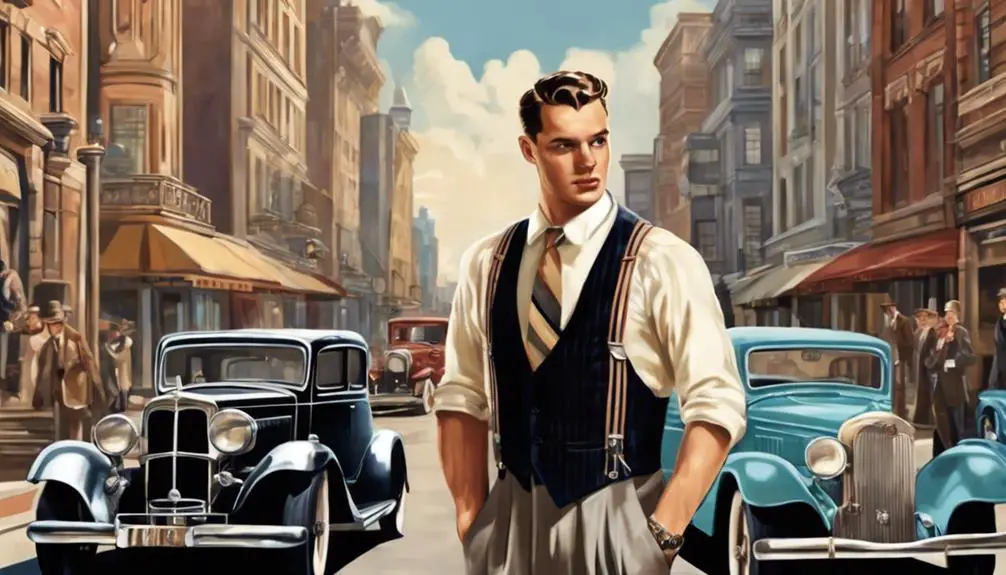
In the 1930s, men's suspenders became a staple accessory that reflected the era's evolving fashion landscape. As high-waisted trousers gained popularity, suspenders emerged as a more practical alternative to belts, providing essential support while enhancing overall style. You'd notice a variety of designs, with button and clip-on suspenders catering to both casual and formal outfits, making them versatile fashion accessories. Vintage clothing labels often provide valuable insight into the era's fashion choices, highlighting the craftsmanship of these items.
The materials used for suspenders during this decade included silk and cotton, often adorned with decorative patterns and vibrant colors that mirrored contemporary fashion trends. This period marked a significant shift; suspenders were no longer merely functional undergarments but bold fashion statements. They became visible elements of men's fashion, showcasing personality and flair.
Influential figures, particularly Hollywood stars, played an important role in popularizing suspenders, elevating them to symbols of sophistication. Their endorsement helped embed suspenders into the fabric of men's style culture, encouraging men to embrace this accessory with confidence. As you explore 1930s fashion, it becomes clear that suspenders are not just about utility; they signify a pivotal moment where functionality harmonizes with aesthetic appeal, shaping the way men dressed for various occasions.
Popular Styles and Designs
Suspenders in the 1930s showcased a dynamic blend of style and functionality that captured the essence of the decade's fashion. As you explore the popular styles and designs, you'll notice that bold colors and intricate patterns were all the rage. The introduction of the Y-back design not only provided a sleek silhouette but also offered essential support for high-waisted trousers, seamlessly blending practicality with elegance.
Moreover, the shift to metal clips marked a significant evolution in their design, allowing for easier attachment and greater versatility. This change enabled men to express their individuality while enhancing the overall sophistication of their attire.
Here's a closer look at some popular styles from the 1930s:
| Style | Description |
|---|---|
| Y-back Designs | Sleek and supportive, perfect for high-waisted trousers. |
| Bold Color Patterns | Vibrant hues that added flair and personality. |
| Elegant Jacquard Styles | Luxurious materials that elevated formal wear. |
These styles, often paired with vests and tailored suits, epitomized the era's emphasis on elegance and well-fitted clothing, making suspenders a must-have accessory.
Materials Used in Suspenders
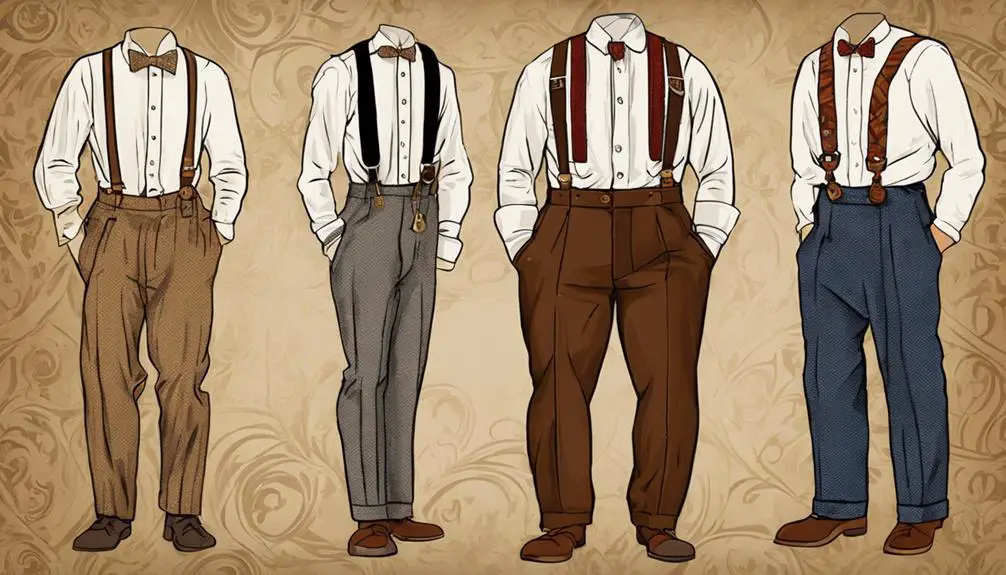
Crafted from a variety of materials, the suspenders of the 1930s reflect both the era's fashion sensibilities and practical needs. Cotton was a popular choice, offering comfort and breathability, making it ideal for daily wear. The era also saw a rise in the use of silk, which added a level of sophistication and luxury to men's attire. Silk suspenders often featured jacquard patterns, intricately woven designs that enhanced their elegance and visual appeal.
Elastic materials were commonly used as well, providing flexibility and ensuring a snug fit. Leather played an essential role, particularly for the straps and attachments, adding durability and a touch of rugged charm. The combination of these materials not only catered to the aesthetic demands of the time but also addressed the functional needs of active men.
In the 1930s, suspenders often featured button attachments for a secure fit, but the introduction of metal clips in some designs offered a more convenient alternative. This shift made suspenders more accessible for everyday wear, blending style with practicality seamlessly. Ultimately, the materials used in suspenders during this decade encapsulated the balance between elegance and functionality, defining men's fashion in a transformative era.
Fashion Icons of the Era
The 1930s witnessed a remarkable transformation in men's fashion, with iconic figures like Cary Grant and Fred Astaire elevating suspenders to a symbol of sophistication. These fashion icons often paired suspenders with tailored suits and classic dress shirts, perfectly embodying the era's shift towards a polished, masculine aesthetic. The influence of Hollywood glamour can't be overstated; stars like Clark Gable donned suspenders in films that showcased their debonair personas, making them a staple for well-dressed men both on-screen and in everyday life.
Suspenders evolved from mere functional items to fashionable statements, with various materials and patterns gaining popularity. This allowed men to express individuality while adhering to the decade's fashion trends, characterized by high-waisted trousers and sharp silhouettes. The embrace of suspenders reflected a broader cultural movement that celebrated refinement and elegance, setting the standard for men's fashion.
As you explore the 1930s, consider how these icons not only popularized suspenders but also influenced the overall landscape of men's style, intertwining functionality with a sense of flair that continues to resonate in contemporary fashion.
Suspenders in Everyday Wear
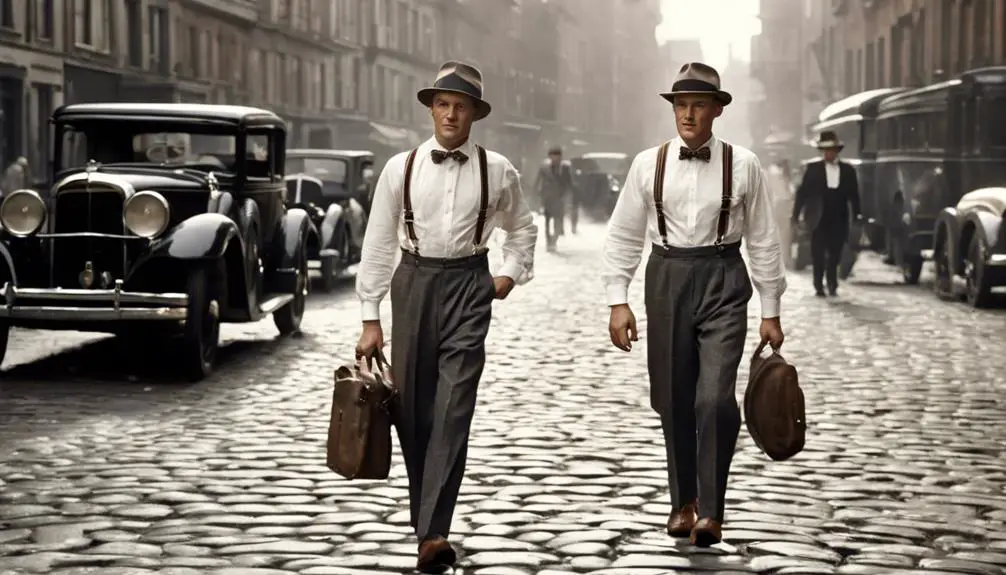
How did suspenders become an essential part of everyday menswear in the 1930s? As the decade unfolded, suspenders emerged as a fashionable alternative to belts, particularly for high-waisted trousers that defined the era's style. You'd notice a diverse array of suspender styles, from classic button designs to convenient clip-ons, catering to varying fashion preferences and functional needs. The variety of vintage tag identification available during this time also allowed consumers to appreciate the craftsmanship behind these accessories. Suspenders were crafted from durable materials like cotton and elastic, allowing them to withstand daily wear while offering a canvas for personal expression. Patterns and colors ran the gamut, letting you inject personality into your casual attire. This period also heralded the "working man" style, where suspenders became commonplace among laborers and office workers, striking a balance between practicality and style.
Culturally, suspenders symbolized professionalism, making them a staple in both workplaces and social gatherings. Their versatility meant they could be worn with a range of outfits, solidifying their place in everyday menswear. In this way, suspenders weren't just functional; they became a statement piece, reflecting the wearer's identity and the evolving fashion landscape of the 1930s.
Practical Benefits of Suspenders
Suspenders offer several practical benefits that set them apart from traditional belts, making them an appealing choice for many men in the 1930s. One of the standout advantages is their ergonomic support; suspenders distribute the weight of trousers evenly across your shoulders, considerably reducing strain on your lower back. This feature is especially valuable for men with larger waistlines, as suspenders eliminate the discomfort caused by the constrictive nature of belts.
Moreover, the adjustable features of suspenders guarantee a comfortable fit, accommodating any changes in your body size or clothing style over time. They also enhance your posture by promoting proper spinal alignment, which can alleviate discomfort and contribute to overall health. Historically, suspenders were favored in physically demanding jobs, allowing for greater freedom of movement and comfort.
Here's a quick comparison of the benefits:
| Feature | Suspenders |
|---|---|
| Ergonomic Support | Yes |
| Adjustable Features | Yes |
| Promotes Good Posture | Yes |
Notable Brands in the 1930s
In the 1930s, the market for men's suspenders flourished, driven by a blend of practicality and style. Notable brands emerged, each offering unique qualities that appealed to various tastes and needs.
- Albert Thurston: This brand led the market with high-quality suspenders, showcasing impeccable craftsmanship and durability in their designs. Their products became synonymous with elegance and reliability.
- Trafalgar: Known for their silk suspenders, Trafalgar gained prominence during this era, particularly for formal occasions. Their jacquard silk suspenders featured intricate patterns that appealed to those seeking a stylish touch.
- Dockers: Catering to everyday wear, Dockers began to establish themselves by providing practical and reliable suspender options that combined function with a hint of sophistication.
The rise of jacquard silk suspenders during the decade was significant, as they connected wearers to the vintage fashion of the time. Additionally, brands like Historical Emporium capitalized on this nostalgia, producing vintage-inspired suspenders that resonated with consumers enthusiastic to embrace the aesthetics of the 1930s. These brands not only defined the era but also set a precedent for the future of men's suspenders.
Cultural Impact on Fashion
Fashion in the 1930s underwent a significant transformation, with suspenders emerging as a prominent symbol of style and sophistication. As you explore this decade, you'll notice that suspenders became the fashionable alternative to belts, often worn visibly over shirts. This shift allowed men to express their individuality, with patterned silk suspenders showcasing personal style and social status.
Hollywood played a vital role in this cultural narrative. Influential figures like Cary Grant and Clark Gable graced the silver screen donning suspenders, solidifying their status as an essential component of sophisticated menswear. Their polished appearances contributed to the broader perception of the "well-dressed man" during the era.
Amid the economic hardships of the Great Depression, suspenders also offered practicality. Working-class men favored them for their durability and functionality, which strengthened their cultural association with resilience and class. This blend of style and substance in men's fashion highlights how suspenders transcended mere utility, reflecting a growing desire for elegance and refinement in the 1930s. Ultimately, suspenders became more than an accessory; they represented a cultural shift toward a more expressive and stylish masculinity.
Transition From Function to Fashion

The evolution of men's suspenders in the 1930s epitomizes a remarkable change from mere functionality to a celebrated fashion statement. As suspenders shifted from being hidden beneath clothing to being worn visibly, they became stylish accessories that enhanced outfits. This transformation coincided with the rise of high-waisted trousers, where suspenders provided both practical support and aesthetic appeal.
Key elements of this fashionable change include:
- Luxurious Materials: The introduction of silk and patterned fabrics reflected changing fashion sensibilities, emphasizing sophistication.
- Wider Straps: The adoption of wider straps not only improved comfort but also allowed for bolder designs, making suspenders a personal expression of style.
- Influence of Celebrity Culture: With Hollywood's burgeoning influence, iconic figures embraced suspenders, solidifying their status as must-have fashion items.
In the 1930s, suspenders were no longer mere garments; they became essential components of a stylish wardrobe. This era marked a pivotal moment where function seamlessly intertwined with fashion, allowing you to express individuality while staying true to the era's aesthetic.
Legacy and Modern Resurgence
Suspenders from the 1930s left an enduring mark on men's fashion, shaping how these accessories are perceived today. During this vibrant decade, suspenders evolved from mere functional garments to essential fashion statements, often coordinating with the wearer's outfits. The shift toward wider, more decorative designs, featuring luxurious materials like silk, reflected a growing emphasis on style and individuality.
These suspenders became synonymous with leisure and elegance, frequently donned by Hollywood stars and affluent individuals, solidifying their status in popular culture. This legacy didn't fade; instead, it laid the groundwork for a resurgence in modern fashion. The 1980s and 1990s saw a revival of retro styles, reigniting interest in 1930s designs and their sophisticated allure.
Today, many brands and designers draw from this rich history, offering contemporary interpretations of suspenders that retain their classic charm while catering to modern tastes. You'll find a wide range of options, from bold patterns to sleek, minimalist designs, allowing you to incorporate this timeless accessory into your wardrobe. In doing so, you connect with a heritage that celebrates both functionality and style, making suspenders a staple in today's fashion landscape.
Frequently Asked Questions
Did Men Wear Suspenders in the 1930s?
Yes, men did wear suspenders in the 1930s. They often chose wider designs for both functionality and style, pairing them with tailored suits and vests, which reflected a polished, sophisticated look prevalent during that era.
When Did Men Stop Wearing Suspenders?
Men started favoring belts over suspenders in the late 19th century, as comfort and practicality took precedence. By the 1920s, this shift solidified, considerably reducing suspenders' presence in everyday fashion throughout the following decades.
What Accessories Did Men Wear in the 1930s?
In the 1930s, you'd notice men accessorizing with fedoras, pocket squares, and cufflinks. Leather gloves added sophistication, while these details reflected personal style, elevating their outfits and showcasing their attention to fashion and elegance.
In What Decade Were Suspenders Popular?
Suspenders gained immense popularity in the 1930s, transforming from mere functionality to fashionable statements. You'll notice their vibrant colors and patterns reflected the era's style, making them essential for both formal and casual attire.
